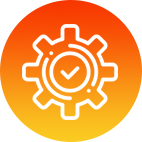
- functional testing
Regulate Production with Functional Testing
For launching a successful application you need a committed team that can evaluate functional components of your product as well as guarantee its stability and reliability before the rollout. This requires a prolific combination of experience and expertise both in manual and automated testing approaches.
The dynamics of software testing have changed today, and functional testing has taken the center stage for ensuring you get what you had actually demanded alongside a high-performance. A rigorous framework-based methodology, combined with seasoned skillset is what brings about a testing phase that regulates compliance to the scope.

Functional Testing at Infiwave Covers
Smoke Testing The preliminary testing procedure used to determine if the application under test is stable and safe for further testing.ptance tests, and so on.
Module Testing Module testing is used to analyse specific sub-programs without evaluating the entire software application.
Regression Testing Perform regression testing to ensure that any new additions have no unexpected consequences for the software application.
Integration Testing Integration testing is used to examine separate components and determine how they work together.
Cross-Platform Testing Excellent testing strategy for ensuring the operation of a software application across several operating systems, web browsers, and devices.
Sanity Testing When there are small modifications to the system, sanity testing is conducted to check that the functionality remains as intended.
System testing Prior to user acceptability testing, investigate end-to-end system requirements to identify maximum flaws.
User Acceptance Testing Actual software users are involved to guarantee that it can perform needed activities in real-world circumstances according to the requirements.
Functional Testing Process at Infiwave

- Requirement Analysis: A team of testers collaborates with developers and stakeholders to prevent ambiguous specification requirements.
- Test Planning: Drafting of test strategy and production of test cases in accordance with the predetermined plan, while keeping each need in the specification in mind.
- Automated Testing: Automating functional testing with the goal of reducing human mistakes and shortening test cycles.
- Managing Defects: Submission of all identified problems to the defect tracking system, followed by exploratory testing to verify no issues were overlooked.
- Test Reporting: Creating a test progress report that includes specific information such as run tests, results, and defects discovered.
- Final Analysis: Providing a comprehensive picture of associated programme quality, together with repair recommendations communicated with clients.
Why Choose Us?

Affordability
Our QA team excels in balancing test selection and vulnerability detection to eventually minimise testing time and cost.

Velocity
We continuously run automated tests to get risk-based feedback and ensure timely product releases.

Risk Assessment
Our functional testing method takes into account inputs relating to project risks, technological risks, and business risks.

Talent
Rapid identification of severe functional flaws and problematic components that might jeopardise software product quality.